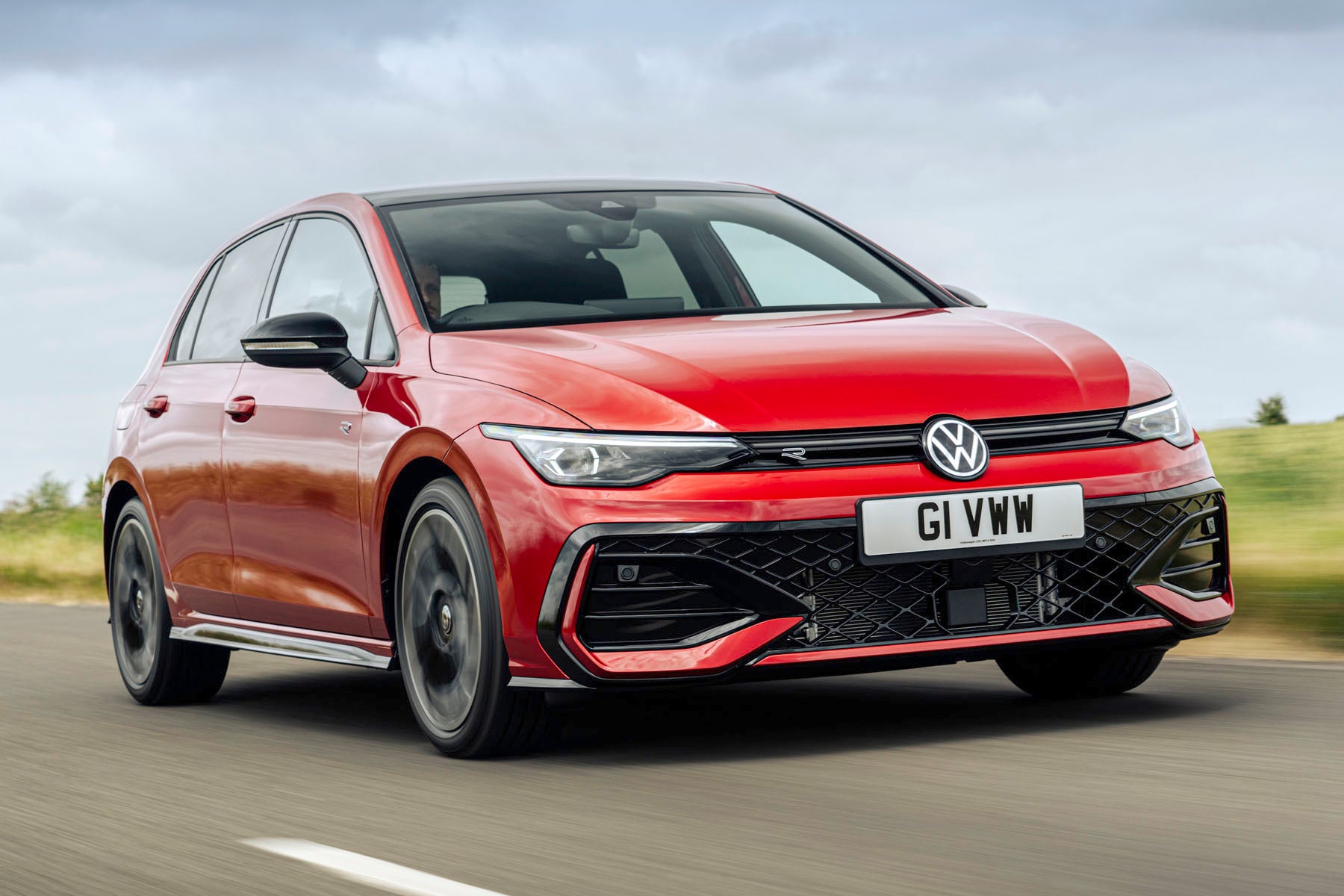Volkswagen Golf Review 2025: Price, specs & boot space
Written by Andrew Brady
Quick overview
Pros
- Comfortable, refined and good to drive
- Even the most affordable models are well-equipped
- Running costs won’t break the bank
Cons
- Buggy media system on earlier models
- Parts of the cabin aren't as plush as you might expect
- Pricier than some rivals
Overall verdict on the Volkswagen Golf
"The Volkswagen Golf has more competition than ever, yet it remains one of the best cars in its class. It’s good to drive, has a sharp interior and we like how it looks, too. Updates in 2024 addressed one of our biggest criticisms _ it now has a much more user-friendly infotainment system."
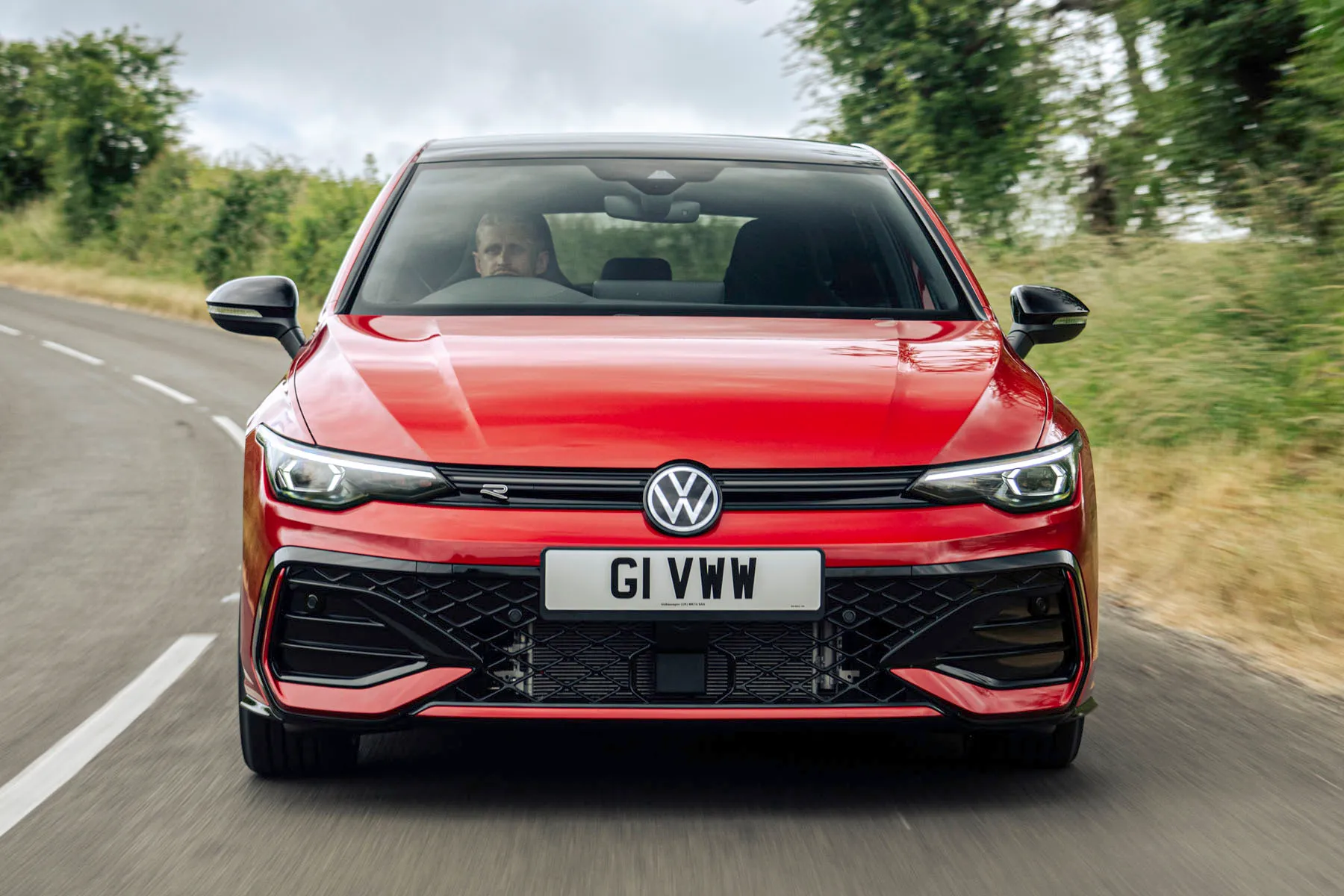
The Volkswagen Golf has been the default choice of many car buyers for decades. Whether you need a dependable family car, a comfortable commuter car or are downsizing from a bigger, more luxurious model, its wide range of abilities suit many needs. It's even a favourite of enthusiasts, particularly in GTI form. We're reviewing the standard car here, however.
Now in its eighth generation, the latest model is packed with digital tech and has a stylish cabin that could rival more expensive rivals. There’s a wide range of engines on offer and even the most affordable models are loaded with standard equipment.
The standard Golf range is made up of four models: the Life, Match, Style and R-Line. The Life really doesn’t feel like an entry-level model (but neither does it have an entry-level price tag, you could argue). Standard equipment on all models includes a 12.9-inch infotainment display, an impressive digital instrument cluster and fancy ambient interior lighting.
The higher-spec models really start to knock on the doors of those premium alternatives. The Style gets various cosmetic and kit upgrades including 17-inch alloy wheels and some chrome exterior trim, while the R-Line features a host of bespoke exterior detailing, selectable drive modes and sports seats embossed with the R-Line logo.
A Black Edition model was added in 2024, which as the name suggests has black design elements on the outside, inspired by the Golf R hot hatch. It is also available with 4MOTION all-wheel drive.
All Volkswagen Golf models get a superb interior, with classy chrome finishes and a minimalist appearance. The media system really looks the part, with instant wow factor thanks to its sharp graphics and smartphone-like usability. It loses favour as soon as you try to use it on the move, however - a lack of conventional buttons means it can be distracting and awkward to operate on a bumpy road.
As well as a variety of trim levels, there's also an extensive range of engines available - there really is a Golf to suit every buyer. We rate the 1.5-litre petrol as a strong all-rounder (especially with the DSG automatic gearbox and mild-hybrid technology to improve efficiency), but you can also buy a plug-in hybrid or even a diesel Volkswagen Golf.
Just like every other Volkswagen Golf before it, the latest model feels solid and competent to drive. You can’t chuck it around like a Mazda 3 or Ford Focus, but it feels reassuringly solid - leaning less in the bends than crossover SUV alternatives like Volkswagen's own T-Roc.
You’ll pay more for a Volkswagen Golf over most family hatchbacks, but it’s worth every penny. Sure, it’s not without its faults, but nothing really beats it as an overall package.
Looking for a used car for sale? We've got 100s of Volkswagen Approved Used Cars for Sale for you to choose from, including a wide range of VW Golf models for sale. If you're looking for the older version, you need our Volkswagen Golf (2013-2020) review.
Is the Volkswagen Golf right for you?
The Volkswagen Golf is so good at what it does yet totally inoffensive with it, it’s hard to imagine a buyer it wouldn’t suit down to the ground. From aspirational go-getters to family buyers looking for a touch of class, the Golf will look subtle yet smart on anybody's driveway.
Not that it’s perfect for everyone. If you like to use a physical button to adjust the temperature or change the volume, you might wish to look elsewhere at cars such as the Mazda 3 or BMW 1 Series. Volkswagen used to be a byword for ergonomic design, but the latest Golf interior takes some getting used to.
It's also worth noting that the Volkswagen Golf isn't as large inside as its cheaper siblings, the Seat Leon and Skoda Octavia. The former has more leg space in the back, while the latter also has a bigger boot. Family buyers after more space for children and luggage might want to look at the estate version, or one of the huge number of mid-size SUVs on sale today.
What other cars are similar to the Volkswagen Golf?
The Volkswagen Golf might be one of the best family cars on the market, but there’s no shortage of impressive alternatives for your consideration.
The latest Honda Civic is one of our favourites - with a generous amount of standard equipment and a very efficient hybrid powertrain. The Toyota Corolla is worth a look, too, especially if you're looking for a reliable car that you can keep for a long time.
The Mazda 3 is a stylish alternative with a superb cabin, while the Ford Focus is a good choice for those who want a car that's fun to drive. You could also look at Volkswagen Group alternatives, like the similar yet cheaper SEAT Leon and the bigger (and more practical Skoda Octavia).
The Volkswagen Golf isn’t far off competing with more premium rivals, too. It’s very nearly in the same league as the pricier Audi A3, while we reckon it’s as good as the BMW 1 Series in many ways. If you’d like a more upmarket choice, the Mercedes A-Class is definitely worth a look.
Comfort and design: Volkswagen Golf interior
"The cabin is what really elevates the Volkswagen Golf over mainstream rivals like the Ford Focus. Even the most affordable Life trim has an interior that feels like a totally classy affair, with chrome dash inserts and quality materials."
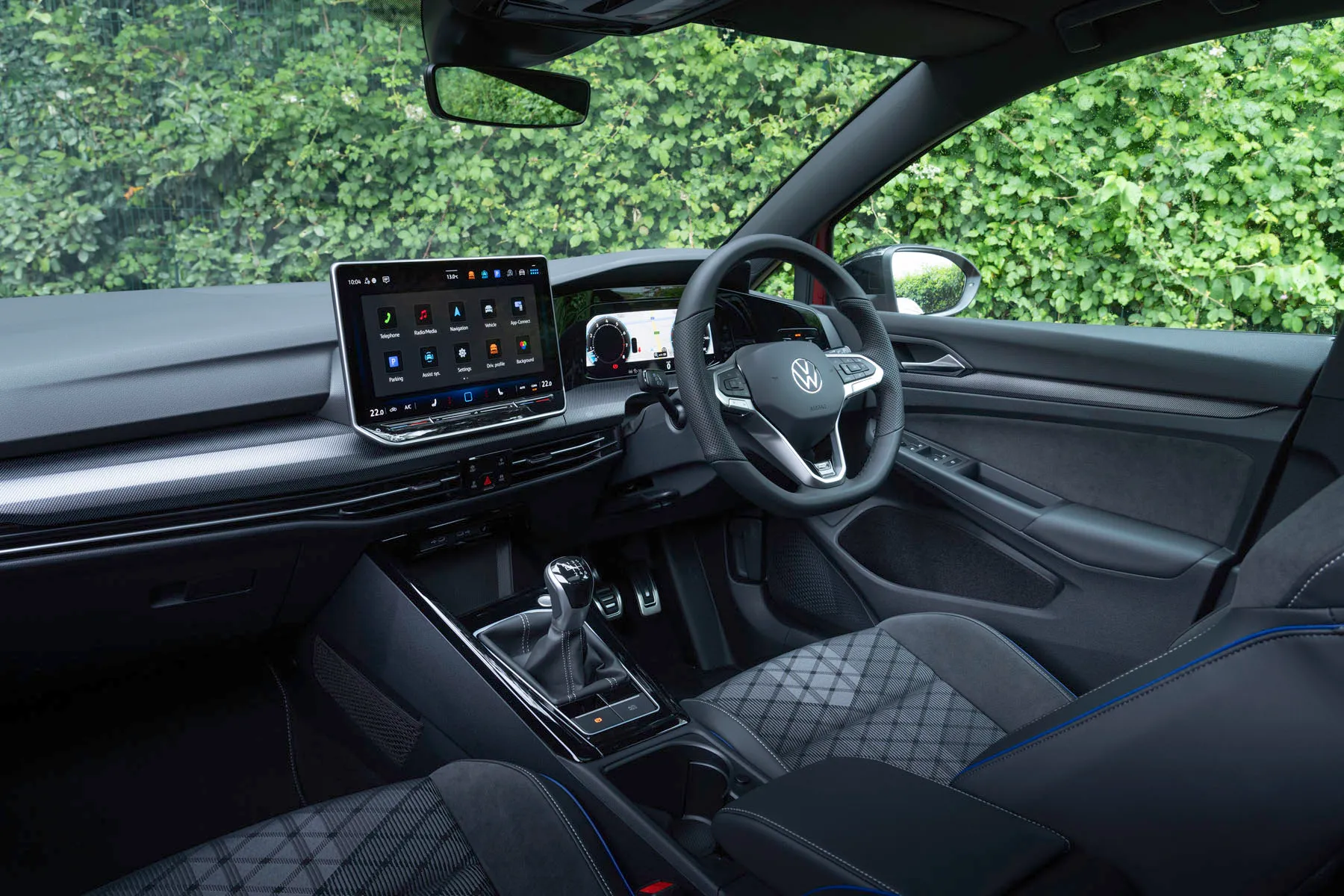
The Volkswagen Golf has a very minimalist layout, with the 10-inch infotainment screen and 10-inch high-res digital instrument cluster taking centre stage in a fairly sober but classy cabin.
There are lots of touch-sensitive buttons for things like the climate control and even controlling the car’s lights. These look pretty swish but are more than a little frustrating to use, especially on the move. Maybe we’re a little old fashioned, but we’d like a few more knobs and buttons for adjusting the temperature or changing the volume. What's more, the touch sensitive strip under the infotainment screen for the temperature and volume isn't backlit at night, so you can't use it. Baffling...
Some buyers are apprehensive about digital dials - and rightly so. They can sometimes overload you with information, when all you want is to know how fast you’re going. Fortunately, the Golf’s system is excellent. It has crystal clear graphics and you can choose from a number of different displays, allowing you to choose which suits you best. It’s easily customisable, too.
The Golf is a very easy car to get comfortable in. The front seats are very supportive, with manual lumbar adjustment across the range, and there’s plenty of adjustment in the seats and steering wheel. Indeed - we were surprised how far the steering wheel could be pulled towards the driver. It’s great if you’ve got long legs and short arms.
Quality and finish
The Volkswagen Golf has been a byword for high quality interiors since the peerless Mk4 Golf of the nineties, and this is still the case for the eighth-generation model. For the most part, anyway.
It feels very well finished, and certainly a step above the Ford Focus, with a more attractive design and a greater feeling of solidity. Its minimalist design looks very premium, helped by things like the touch-sensitive buttons and bright digital screens for both the infotainment and instrument cluster.
You can sense the ‘but’ coming. Start prodding around the cabin, and it’s a little surprising how many harsher plastics can be found. The lower half of the door cards (surrounding the door bins) feel a bit flimsy, while a big chunk of plastic on the centre console is anything but soft-touch and will start to show up dirt and scratches. It is still better than the SEAT Leon, but not by as much as it used to be.
We’re being quite picky because of the Golf’s reputation as a quality product. Its doors still close with a satisfying thud and it’ll no doubt wear very well indeed. But it’s almost like Volkswagen’s had to reign it back, in order to give buyers a reason to pay more money for an Audi A3.
Infotainment: Touchscreen, USB, sat nav and stereo in the Volkswagen Golf
One of the upgrades for 2024 is the addition of a 12.9-inch touchscreen media system that's standard across the Volkswagen Golf range. An update to the operating system means it's much slicker than the 10.0-inch display used in earlier models - the responses are quick, while you can create customised shortcuts to your favourite features.
The latest updates also seem to have fixed the software glitches that affected early examples of the eighth-generation Golf.
Apple CarPlay and Android Auto are standard, which is good thing as this means you can access apps from your phone on the move with an intuitive, familiar interface. There’s also DAB radio, Bluetooth and navigation with European mapping.
Space and practicality: Volkswagen Golf boot space
No one’s going to find a lack of space in the front of the Volkswagen Golf. There’s loads of headroom, particularly if you drop the seat to its lowest setting. The pedals are nicely separated, meaning you won’t accidentally mash more than one if you have big feet, and there’s space to rest your left foot when it’s not in use.
A wide centre console separates the driver and front-seat passenger, although you might find yourself clashing elbows on the armrest. Nevertheless, this is definitely one of the most comfortable front cabins in the class.
There are loads of handy storage spaces, too. You’ll find big carpet-lined door pockets and a handy space in front of the gear lever to store your phone (and wirelessly charge it). The cup holders are big enough for more uses, while there’s a small cubby area underneath the arm rest.
In the back, there’s a reasonable amount of room, but oddly the Golf isn't quite as spacious as the Skoda Octavia or SEAT Leon it's closely related to. That's because both of those cars get a longer wheelbase, meaning extra room for your legs and knees. Legroom in the Golf is okay, rather than astounding, but there’s plenty of headroom. The child seat ISOFIX mounting points are easy to get at, and the large side windows mean kids shouldn’t feel too claustrophobic.
As is usually the case in cars of this size, the middle rear seat is for occasional use only. It’s not as narrow as some, but you’ll still be rubbing shoulders with other passengers. There’s quite a significant lump in the floor meaning you’ll be fighting for somewhere to rest your feet, too.
Still, there are handy door pockets for storing odds and ends, and some nifty little pockets in the backs of the front seats. With the middle seat not in use, an armrest drops down and provides a pair of useful cup holders.
At 381 litres, the boot is fine for a car of this size. It’s pretty much on a par with the Ford Focus and bigger than a Mazda 3 although - again - lacks behind the Skoda Octavia. There’s a little bit of a lip for hoisting things over but access is nice and wide, and the boot is usefully square in shape. Dropping the rear seats is easy, although they’re not entirely flat. There’s also a useful ski hatch in the middle of the rear bench should you need to transport something long and thin like, er, skis.
All models come with a spare wheel, which is a satisfying sight in the case of a puncture rather than the now commonplace tyre repair kit. It does mean there isn’t a useful underfloor storage compartment in the boot, but you can create one with the standard adjustable boot floor.
In terms of exterior dimensions, the Volkswagen Golf is actually pretty compact for the class. It's 4,258mm long, 1,789mm wide and 1,458mm tall, which is shorter than both the SEAT Leon and Skoda Octavia. It's also a good chunk shorter than the Ford Focus and Honda Civic, too.
Handling and ride quality: What is the Volkswagen Golf like to drive?
"The Volkswagen Golf is available with a variety of suspension setups. Fortunately, we’re yet to try a bad one."
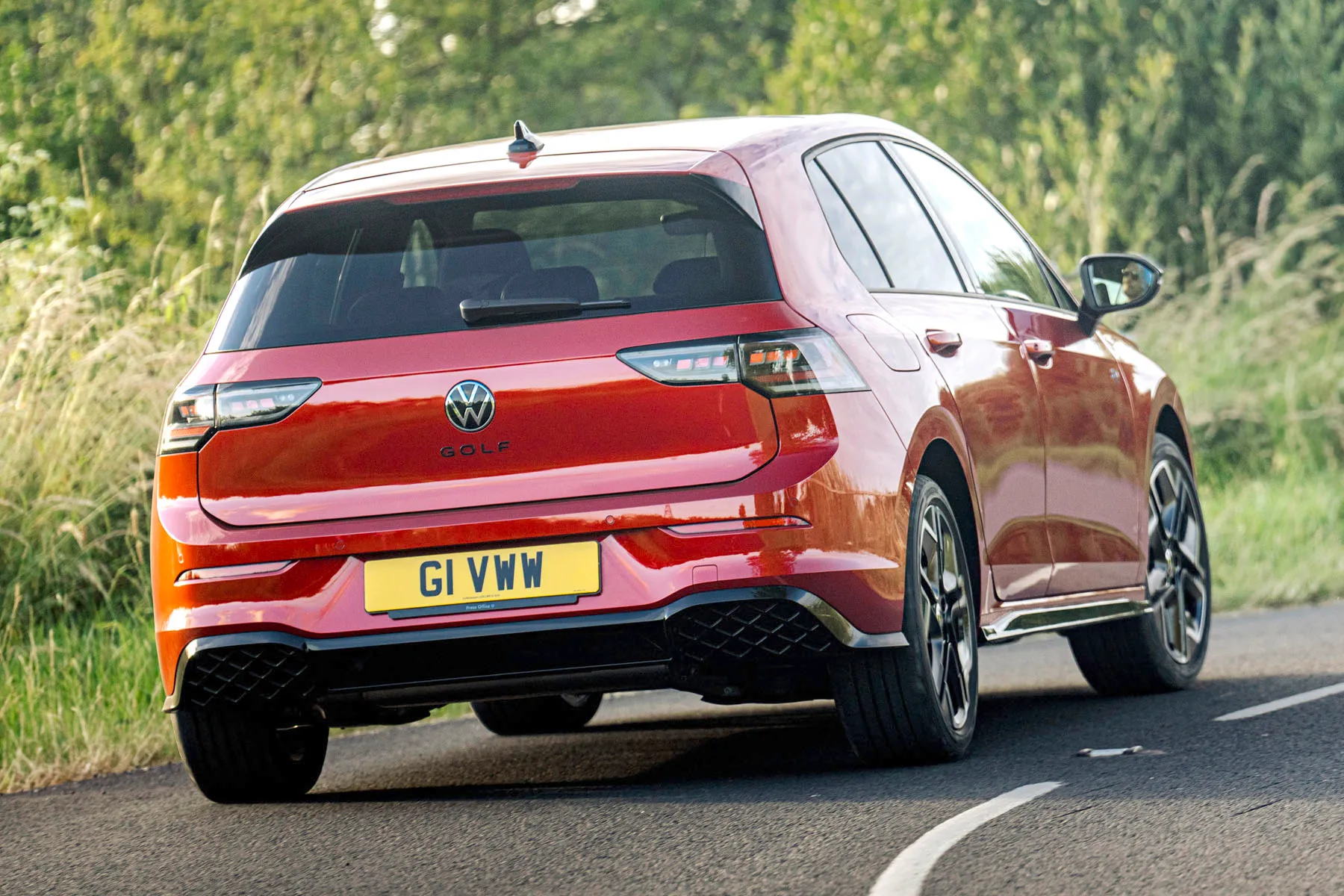
The standard suspension on the Volkswagen Golf - used on Life, Match and Style models - is pretty compliant, soaking up bumpy roads without being too floaty. This is especially true with the smaller 16-inch alloy wheels. Sure, you might prefer the look of bigger wheels, but the smallest alloys provide an almost magic carpet ride.
R-Line models come with sports suspension which lowers the ride height slightly. As you’d expect, this provides a slightly firmer ride - especially with the bigger wheels fitted to the R-Line. It’s far from uncomfortable, though.
Look for a Golf with the optional Dynamic Chassis Control if you wish to tweak the suspension to your liking. Also known as adaptive suspension, this can increase the firmness of the suspension’s dampers in Sport mode, or soften them in Comfort mode. With Comfort mode selected, the Golf rides beautifully over broken roads.
Thanks to the Golf’s rather compact dimensions and decent visibility, it’s a very easy car for negotiating congested streets. You might not get the high-up seating position that attracts many buyers towards SUVs, but no one’s going to feel intimidated behind the wheel.
Front and rear parking sensors are standard across the range, but it’s worth looking for an example with the optional rear-view camera if you’re daunted by tricky reversing manoeuvres. Light, progressive steering helps in tricky situations, although it doesn’t feel quite as agile and engaging on the open road as a Ford Focus.
It does feel secure and planted, though, even in poor weather conditions. And it doesn’t dart around too much at motorway speeds. Look for a Golf with the optional driver profile selection (standard on R-Line) for drive modes which add extra heft to the steering when you’re feeling sporty.
What engines and gearboxes are available in the Volkswagen Golf?
The Volkswagen Golf is available with a pretty expansive range of engines: there's something to suit almost every buyer.
While pre-facelift Volkswagen Golfs were available with a little 1.0-litre petrol engine, the entry-level motor is now a 1.5-litre with 115PS. This is offered with a six-speed manual gearbox or a seven-speed DSG auto transmission; the latter comes with some mild-hybrid electrical assistance. It's not fast but it feels punchy enough for a car of this size – its sub-10.0 second 0-62mph time means it can join a motorway comfortably.
If you want slightly more effortless performance, the same engine is available with 150PS (again, with a six-speed manual gearbox or seven-speed DSG automatic). This will accelerate to 62mph in 8.6 seconds (or 8.4 seconds with the auto 'box). If you're confused about which engine to choose, this is probably the one to go for – it's an excellent all-rounder, providing a good blend of performance and economy.
For those looking for a stepping stone towards an electric car, there are a few plug-in hybrid options. We're yet to try the Volkswagen Golf eHybrid but it looks good on paper: 204PS from its 1.5-litre petrol and electric motor combination, providing a brisk 7.2-second 0-62mph time and up to 88 miles of electric-only driving on a full battery charge. There's also the sporty Volkswagen Golf GTE, which we'll be covering in a separate review.
Diesel might be a dirty word in this day and age, but you can still buy a diesel Volkswagen Golf. The 2.0-litre TDI engine is available with 115PS and a six-speed manual gearbox or 150PS and a seven-speed DSG auto gearbox. We've sampled the former and it'll be fine for those with a keen eye on economy. We wouldn't recommend it for short urban journeys but it could be a good choice if you cover a lot of motorway miles.
Refinement and noise levels
The Volkswagen Golf has the levels of refinement you’d expect from a more expensive car like the Audi A3 or Mercedes-Benz A-Class. At high speeds, it’ll isolate passengers from the outside, doing a commendable job of quashing road and wind noise.
There is a bit of engine noise, depending on which Volkswagen Golf you buy. The diesels create a distinctive rumble, for example, while the petrols will be a bit vocal if you work them hard. They're not noisier than competitors, though.
While we're yet to drive the new plug-in hybrid Volkswagen Golf, it's likely to be the most refined, given its ability to drive under electric power alone.
Safety equipment: How safe is the Volkswagen Golf?
As you’d expect, the Volkswagen Golf is a very safe car to drive and it’s loaded with safety equipment as standard, even on the most affordable models.
All Golfs come with adaptive cruise control which, as well as making your life easier on long motorway trips, also brings with it a second pair of eyes - in a sense. The Front Assist system will measure the distance between your car and the vehicle ahead, warning you if you get too close. If it detects an impending collision, it’ll warn you again and prime the brakes ready for emergency braking. At speeds of up to 19mph, the City Emergency Braking System will automatically brake for you if you don’t react in time - and boost the pressure on the brakes if you do react.
Other standard safety equipment includes many airbags, automatic headlights and an active bonnet which pops up to provide extra cushioning if you strike a pedestrian.
All models get Volkswagen’s Car2X wireless communication feature. This can exchange information with other vehicles as well as the traffic infrastructure. If there’s an incident or a hazard on the road ahead, for example, it can warn you in advance. You could even get alerts of approaching emergency vehicles - although these features will take time to work fully until the infrastructure catches up with the car.
When the Volkswagen Golf was crash tested by Euro NCAP in 2019, it received a maximum five-star safety rating. It scored an impressive 95% for adult occupants and 89% for children. It received 76% for protecting vulnerable road users, while its safety assist features scored 78%.
MPG and fuel costs: What does a Volkswagen Golf cost to run?
"There are some very efficient engines in the Volkswagen Golf line-up. The difficulty will be deciding which one best suits your needs..."
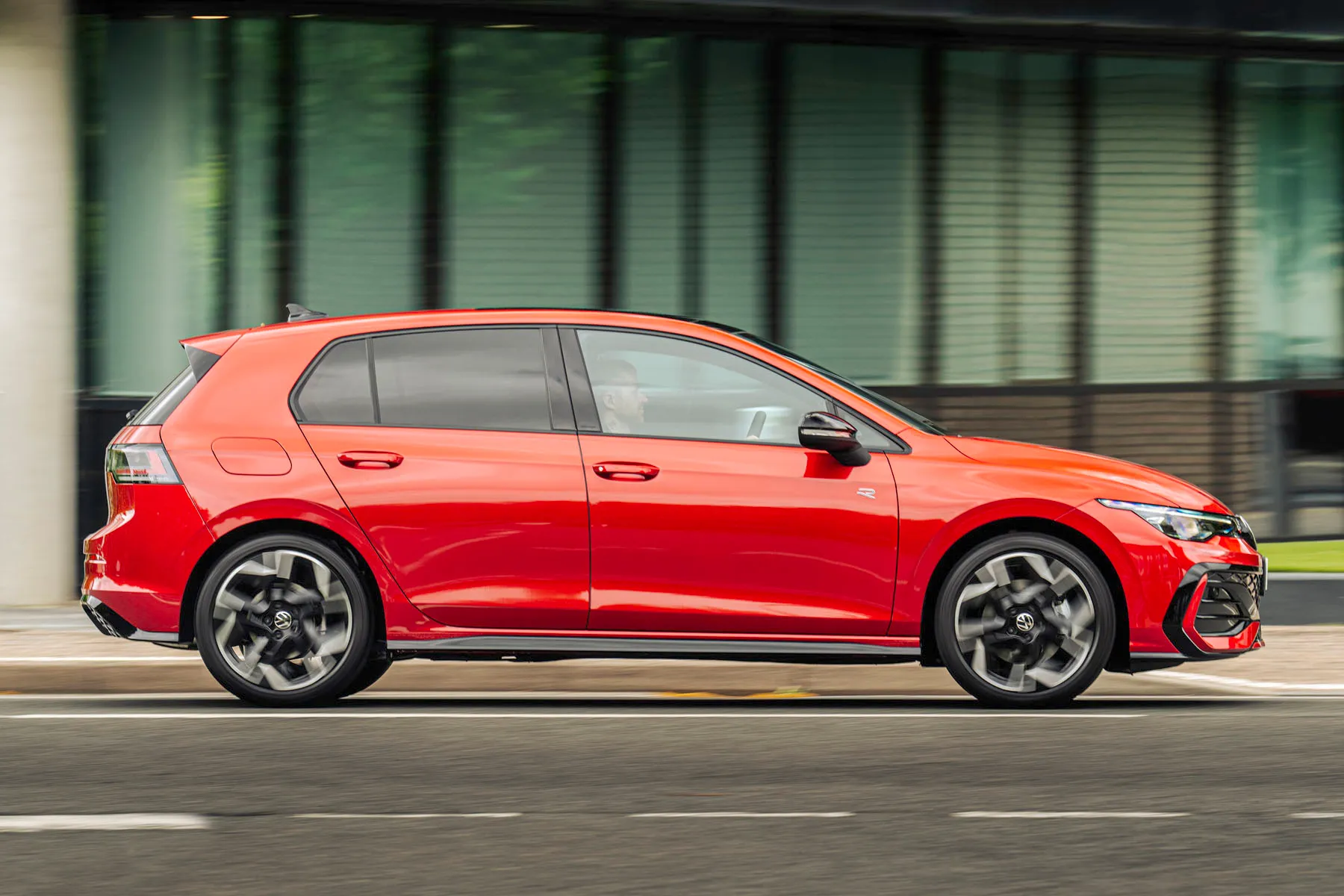
Buy a Volkswagen Golf with the 1.5-litre petrol engine (with or without a small amount of mild-hybrid electrical assistance) and you can expect to see around 50.0mpg. That's pretty frugal for a petrol car - indeed, it's efficient enough that most buyers won't need to look beyond it at the more complex hybrid setups.
The efficiency claims made by the plug-in-hybrid Volkswagen Golf eStyle are hard to ignore, though. Officially the PHEV has a WLTP fuel economy figure of 941.6mpg. We'd take that with a pinch of salt – of greater importance is the impressive 88-mile electric range figure. That means you can charge at home and, in theory, cover up to 88 miles before the petrol engine kicks in. This could be ideal if you're looking for an efficient car for day-to-day commuting with the ability to travel further afield at weekends or for those occasional trips to see family.
If you're looking for a Volkswagen Golf to cover a lot of motorway miles, we'd recommend one with a diesel engine. The 115PS 2.0 TDI officially returns up to 62.8mpg while the 150PS version manages 60.1mpg (a small price to pay for the extra performance as well as the DSG automatic gearbox).
How reliable is the Volkswagen Golf?
The Volkswagen Golf is synonymous with rock-solid build quality and the eighth-generation model is living up to that. Early cars suffered a few niggly software issues (but they were rectified by over-the-air updates); later models, though, seem to be very dependable. Indeed, the engines used in the Volkswagen Golf are well proven across a wide range of VW Group models.
A new Volkswagen Golf comes with a three-year/60,000-mile warranty which can be transferred to subsequent owners. This is pretty standard across the industry, although it's not a patch on the service-activated warranty and you can get for up to 10 years on a Toyota Corolla.
Insurance groups and costs
Volkswagen Golf insurance groups range from 17 to 27, not including the performance Golf GTI and Golf R models.
If you're looking for a Volkswagen Golf that'll be cheap to insure, we'd recommend looking for one of the more affordable, less powerful models. The 115PS 1.5-litre petrol is likely to have the cheapest insurance premiums out of the current line-up. Some of the hybrids (particularly the PHEVs) are surprisingly powerful so will cost more to insure, particularly if you're a young driver.
VED car tax: What is the annual road tax on a Volkswagen Golf?
You'll pay a standard rate of £190/year to tax a Volkswagen Golf, or £180/year for those with hybrid power. Cars with a list price (when new) of more than £40,000 are stung by an extra £410 a year in premium car tax (from years two to six). Fortunately, that won't affect many Golfs this side of the performance models - but it might affect you if you're buying a particularly high-spec secondhand model.
How much should you be paying for a used Volkswagen Golf?
"A budget of around £15,000 will get you a choice of three- or four-year-old Volkswagen Golfs on the used market. Buy one on heycar and it'll be covered by a warranty with a 10-day money back guarantee."
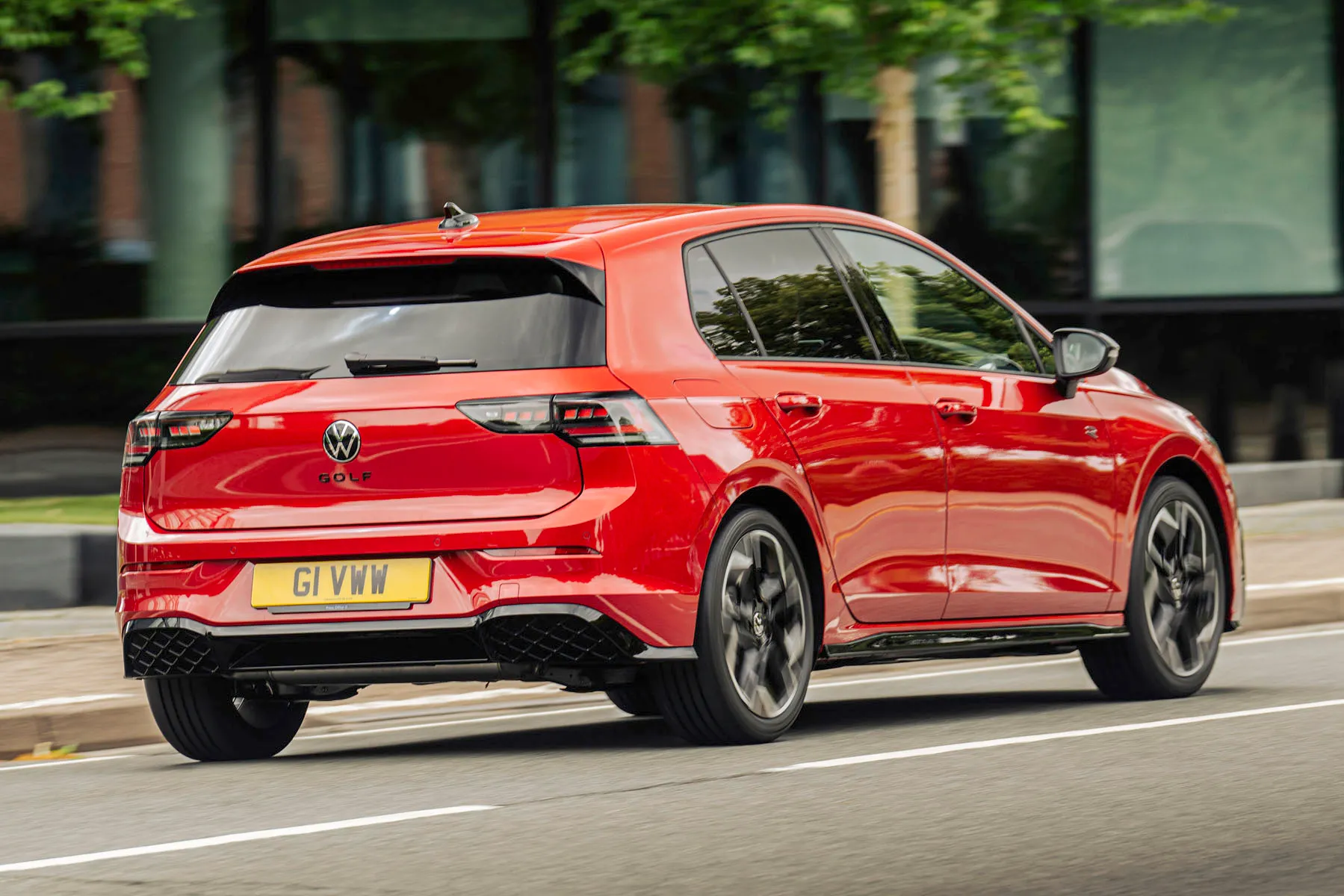
As all Volkswagen Golf models are well equipped as standard, you can be confident that you won't miss out on desirable features by hunting for one on the used market. And while the Volkswagen Golf has recently been updated for 2024, it doesn't look that different to the original 2020 model - so you won't feel like you're missing out there, either.
If you do want a brand new Volkswagen Golf, expect to pay upwards of £27,000 for a brand new one in Life trim. The Volkswagen Golf Match is only a smidgen more expensive, while the Style trim is nearly £30,000 in its most affordable flavour. The Golf R-Line starts from a little over £30,000, while the Black Edition is another £1,000 on top of that. If you're looking at car finance, you should be able to track down a good PCP deal on a Volkswagen Golf as well.
Trim levels and standard equipment
The Volkswagen Golf range kicks off with the Life trim level. Standard equipment on the Volkswagen Golf Life includes 16-inch Norfolk alloy wheels, automatic climate control (Climatronic), enhanced multi-function steering wheel, Dynamic Road Sign Display, cruise control system, and parking sensors at the front and rear. The new MIB4 Discover infotainment system, wireless App-Connect (wireless integration of smartphone apps with Apple CarPlay and Android Auto), mobile phone interface, Digital Cockpit, new LED headlights and LED tail light clusters, and adaptive cruise control (ACC) are also fitted as standard.
The Volkswagen Golf Match adds details such as an exterior chrome package, 17-inch Nottingham alloy wheels in silver, rear tinted glass from the B-pillar backwards, keyless locking and starting system, Keyless Access with SAFELOCK, High Beam Assist and automatic sensing for switching between dipped and main beam. There’s also a rear-view camera as well as a leather multi-function steering wheel and adaptive cruise control (ACC) as standard.
The Volkswagen Golf Style is characterised by 17-inch alloy wheels, individualised bumpers in Style design with chrome strips, and performance headlights with illuminated Volkswagen logo at the front. Inside, the equipment is enhanced by sports comfort seats with ArtVelours covers, plus decorative dashboard and front door panel inserts in New Brushed Dark Metal. Interior ambient lighting with 30 colour options, Air Care Climatronic (three-zone) with rear air conditioning control panel, Rear Traffic Alert and lane change system, alongside an exit warning system, are also fitted as standard.
Outside, the sporty Volkswagen Golf R-Line differs from the Golf Style by distinctive bumpers in the R-Line design and numerous elements in high-gloss black, including the side sill trims. These features are complemented by black 17-inch alloy wheels with diamond-cut outer surfaces. There’s also the addition of sports suspension here. The interior is differentiated from the Golf Style by a leather and heated multi-function sports steering wheel with shift function (for the versions with automatic DSG), driving profile selection and premium sports seats with R-Line fabric seat covers.
The head-turning Volkswagen Golf Black Edition sits between R-Line and the performance models. Features in addition to those on R-Line include larger 18-inch Leeds alloy wheels, black exterior mirror housings, and heated front seats as part of the Winter Package. A lighting upgrade encompasses Matrix LED headlights with automatic headlight control, advanced dynamic light assist, plus poor weather light and entry lighting. There are also LED rear tail lights with dynamic turn signal, cornering and poor weather lights, an illuminated line between the headlights, and illuminated door handle recesses.
Ask the heycar experts: common questions
Is Volkswagen discontinuing the Golf?
How much does the Volkswagen Golf cost?
Is the Volkswagen Golf a good car?
Volkswagen Golf Alternatives
Get our latest advice, news and offers
Keep me updated by email with the latest advice, news and offers from heycar.
By submitting you agree to our privacy policy
